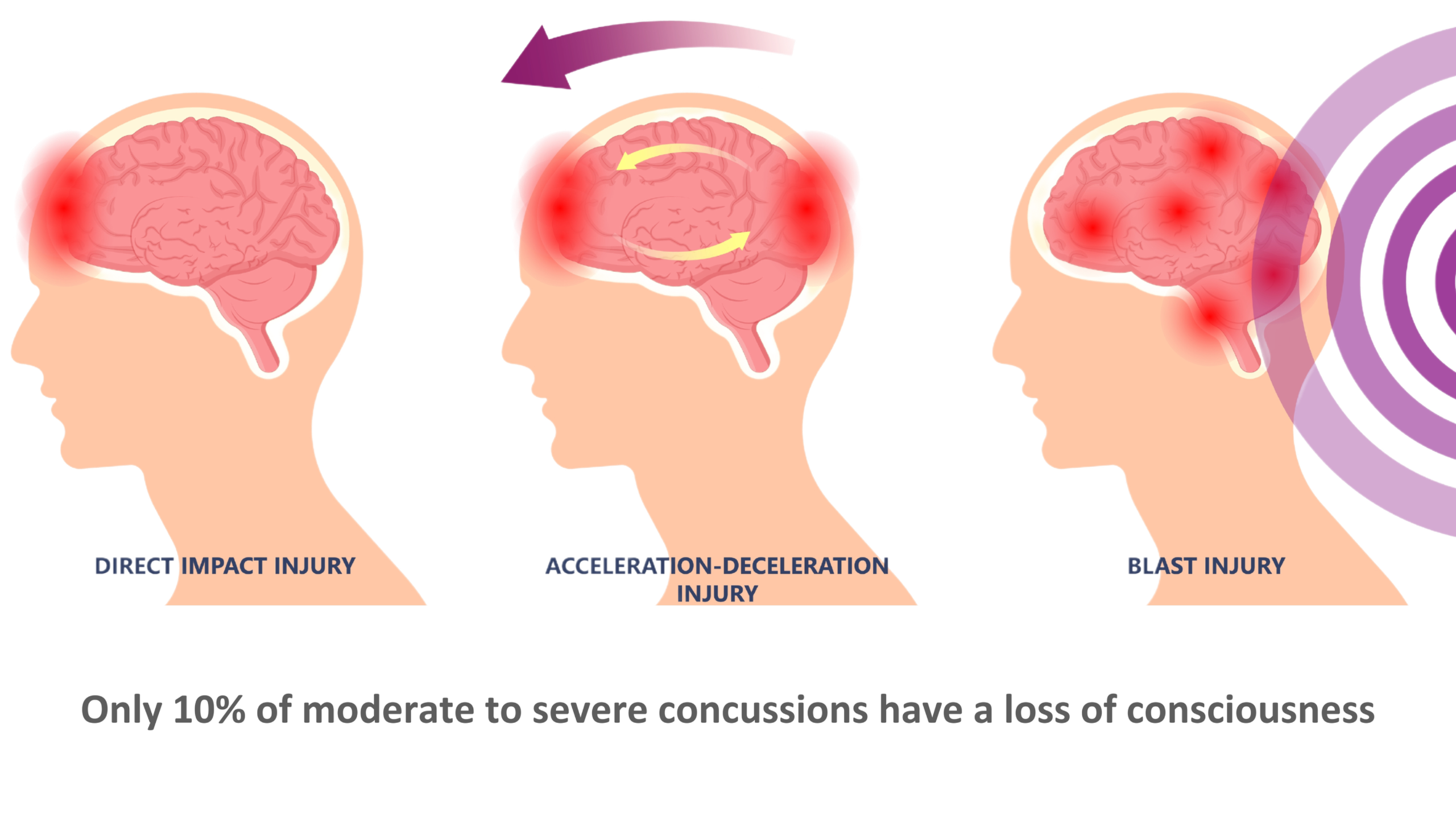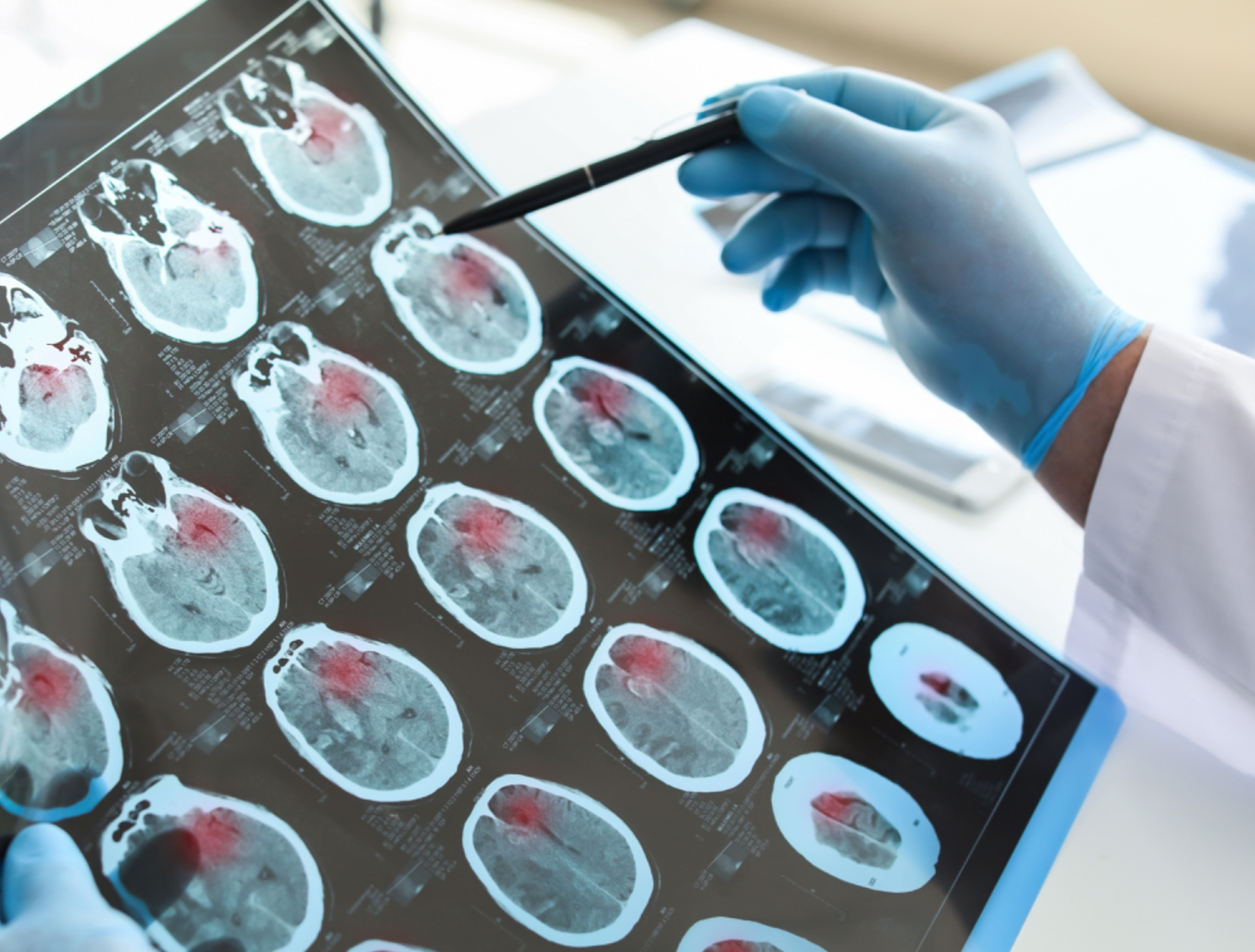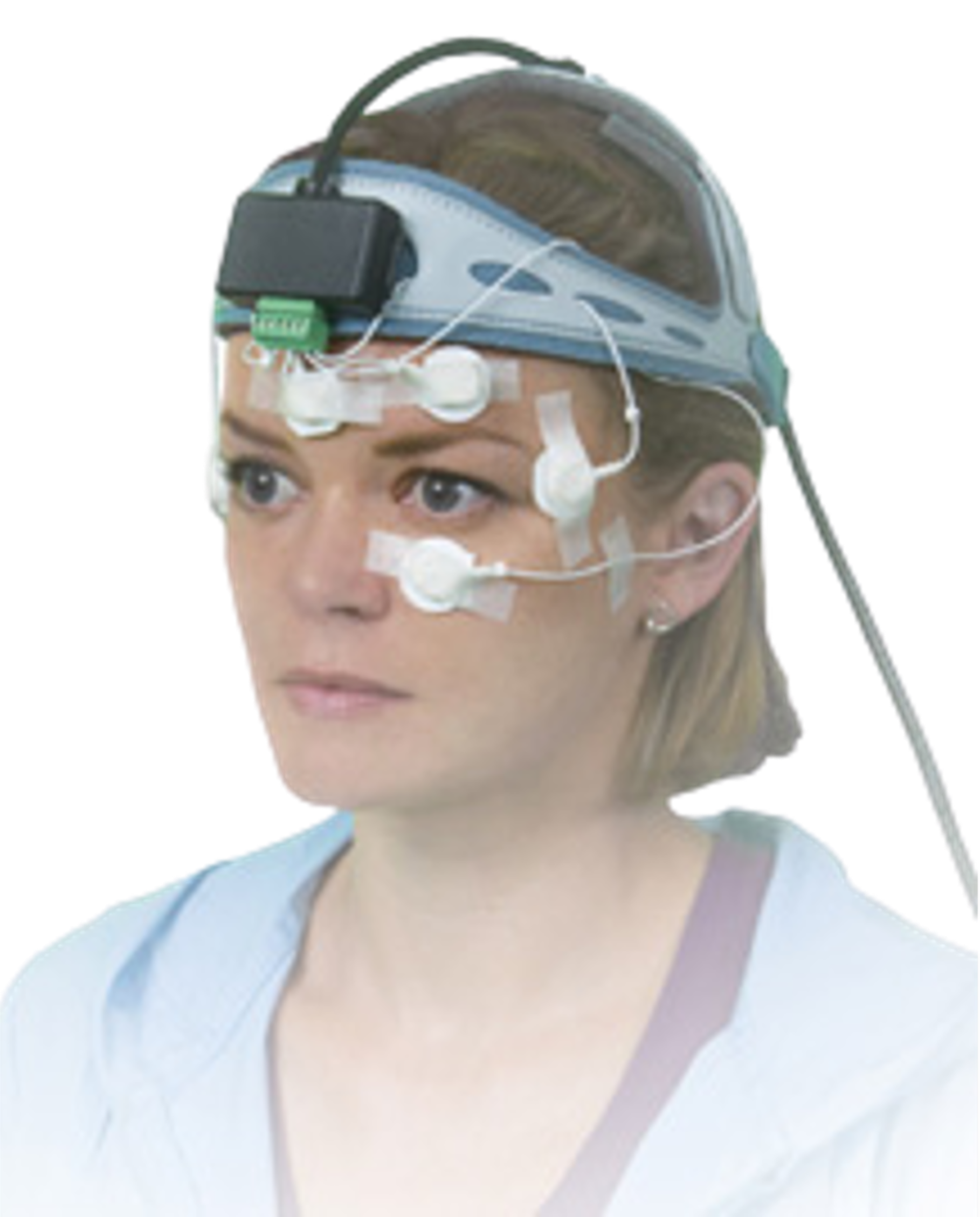Understanding Concussions
Learn about the causes, symptoms, and treatments for concussions. Stay informed to protect your health and well-being.
A concussion is a mild traumatic brain injury resulting from a bump, blow, or jolt to the head, leading to various symptoms such as headaches, dizziness, and cognitive impairments. Early and accurate diagnosis, followed by appropriate management, is crucial for effective recovery. Over 90% of concussions do not involve Loss of Consciousness, a University of Pittsburgh Medical Center indicates that more than 90% of concussions are not accompanied by a loss of consciousness, and the Centers for Disease Control and Prevention (CDC) notes that less than 10% of sports-related concussions among children are associated with LOC.A concussion can result from a direct blow to the head or from forces transmitted to the head from impacts elsewhere on the body. The brain's sudden movement or shaking within the skull leads to neurological disturbances, manifesting as various symptoms. These symptoms can include headaches, dizziness, confusion, balance issues, and visual disturbances, among others. Importantly, the absence of LOC does not diminish the severity of the injury or the potential for significant symptoms.The pre-existing metabolic status, the extent of glutamate activation, as well as the hyperglycemia around the timing of the injury likely affects the pe numbra zone, or the extent of the permanent neuronal loss.
Structural and Functional Impacts of Concussion
Traditionally, concussions have been viewed as functional disturbances without structural damage. However, advanced imaging techniques have revealed that concussions can cause structural damage, particularly to the brain's white matter tracts.This structural damage often leads to an "energy crisis" in the brain, where affected regions cannot effectively utilize glucose, their primary energy source. This impairment can prolong recovery well beyond the commonly cited 7 to 10 days to months and years, which may lead to substantive lifetime financial and functional injury.
Injury Experts and Legal Issues associated with Concussion
Injury Experts and Concussion
The U.S. legal system has addressed the economic impact of concussions through various settlements. For instance, the National Football League (NFL) has faced numerous lawsuits from former players regarding concussion-related injuries. As of early 2023, more than $1 billion in claims have been approved in the NFL concussion settlement, providing compensation to affected players and highlighting the substantial financial implications of concussion-related injuries.Beyond professional sports, individuals involved in accidents resulting in concussions may seek compensation through personal injury claims. Settlement amounts can vary widely based on injury severity, with average payouts for concussion-related injuries following auto accidents in the U.S. reported at $347,046, and median settlements around $50,037.Broader Economic Considerations
The economic repercussions of concussions extend beyond immediate medical costs and legal settlements. Long-term effects can include decreased earning potential due to cognitive impairments, increased healthcare costs for ongoing treatment, and diminished quality of life. These factors contribute to a broader economic burden, affecting not only individuals but also families and communities.Even if you didn't lose consciousness after a head injury, seeking specialized care at a concussion center is essential. Early and appropriate intervention can mitigate the risks of long-term physical, cognitive, and emotional consequences, safeguarding both your health and future prospects.
What most people don't know about concussion
Invisible Injuries Can Lead to Visible Consequences
It's a common misconception that a concussion only occurs if you've been "knocked out." In reality, loss of consciousness happens in only about 10-20% of concussion cases. This means many individuals may suffer a concussion without realizing it, potentially neglecting necessary care.
Delayed Symptoms May Mask Serious Issues
Concussion symptoms can be subtle and may not manifest immediately. They can develop over days or weeks, including headaches, confusion, memory issues, and mood changes. Without proper evaluation, these symptoms might be dismissed, leading to prolonged recovery or complications.
Long-Term Cognitive Decline Is a Real Risk
Even a single concussion can have long-term impacts on brain function. Studies have shown that individuals with a history of concussion may experience cognitive decline, including memory problems and reduced executive function, later in life.
Post-Concussion Syndrome Can Impair Daily Life
Some individuals develop post-concussion syndrome, where symptoms persist for weeks or months after the initial injury. This condition can significantly impact daily activities, work performance, and overall quality of life.
Economic Impact: Reduced Earning Potential
Concussions can lead to decreased productivity and extended absences from work. In some cases, individuals may be unable to return to their previous employment, leading to reduced earning potential and financial strain. The economic repercussions of concussions are substantial. A study published in BMJ Open found that individuals who suffered a concussion experienced an average annual salary reduction of approximately 4.2%, equating to a loss of €1,223. This decline was particularly pronounced among those without a high school education and individuals aged 30 to 39.Fallesen P, Campos B. BMJ Open 2020;10:e038161. doi:10.1136/bmjopen-2020-038161
Emotional and Psychological Effects
Beyond physical symptoms, concussions can cause emotional disturbances such as depression, anxiety, and irritability. These changes can strain personal relationships and diminish overall life satisfaction.
Increased Vulnerability to Future Injuries
Sustaining one concussion increases the likelihood of subsequent concussions, which can have cumulative effects and lead to more severe neurological impairments.
Specialized Care Enhances Recovery Outcomes
Early intervention at a specialized concussion center can provide targeted therapies and management strategies, reducing the risk of long-term complications and promoting a more efficient recovery.
Legal and Financial Considerations
Proper documentation and treatment of a concussion are crucial, especially if the injury occurred due to an accident. This ensures that any potential legal claims for compensation are supported by comprehensive medical records.
Protecting Future Quality of Life
Addressing a concussion promptly and thoroughly is an investment in your future well-being, ensuring that you can continue to enjoy life without the lingering effects of an untreated brain injury.
Innovative Diagnostic Tools
Advancements in technology have introduced several tools that enhance the diagnosis and management of concussions:
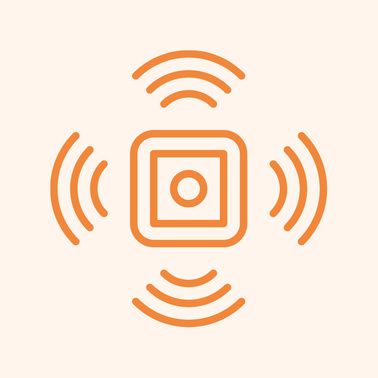
Impact Sensors
Wearable devices, such as high-tech mouthguards, measure the force and direction of impacts in real-time, aiding in the early detection of potential concussions.
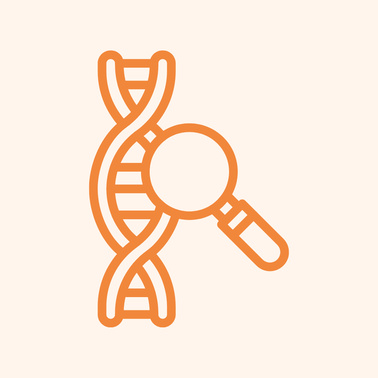
Biomarker Analysis
Research into biomarkers, including blood and saliva tests, offers promising avenues for diagnosing concussions and monitoring recovery progress.
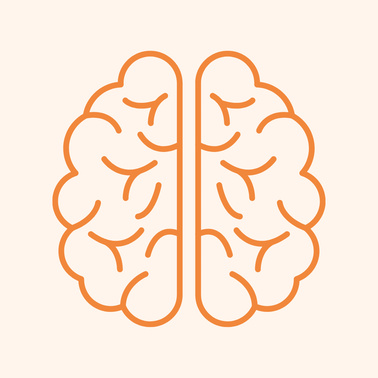
Neuroimaging Techniques
Advanced imaging methods, like functional MRI (fMRI) and quantitative EEG (qEEG), provide detailed insights into brain function, assisting in the assessment of concussion severity.
Videonystagmography (VNG)
Videonystagmography (VNG) has emerged as a valuable tool in assessing concussions by evaluating the vestibular and oculomotor systems, which are often affected by such injuries.
VNG is a diagnostic procedure that records involuntary eye movements, known as nystagmus, using infrared goggles. It assesses the functionality of the inner ear and central motor functions by evaluating:• Ocular Testing: Observing eye movements as the patient follows visual targets.
• Positional Testing: Monitoring eye movements as the patient's head and body positions change.
• Caloric Testing: Stimulating each ear with warm or cool air or water to observe resultant eye movements.These assessments help identify abnormalities in the vestibular system, which is responsible for balance and spatial orientation.VNG in Concussion DiagnosisConcussions can disrupt the vestibular system, leading to symptoms like dizziness, imbalance, and visual disturbances. VNG testing can detect these dysfunctions by analyzing eye movement responses to various stimuli. Abnormal results may indicate vestibular deficits resulting from the concussion.Research supports the use of VNG in concussion evaluation. For instance, a study concluded that a specific cluster of VNG tests could serve as a moderately sensitive and highly specific screening tool for patients suspected of having a concussion.Advantages of Using VNG• Objective Measurement: Provides quantifiable data on vestibular and oculomotor function.
• Early Detection: Identifies vestibular abnormalities that might not be apparent through standard neurological examinations.
• Guided Rehabilitation: Assists in tailoring vestibular rehabilitation therapy by pinpointing specific dysfunctions.
Treatment Modalities
Hypothermic Therapy
Recent studies indicate that controlled cooling treatments can significantly improve symptoms in adolescent concussion patients.
Hyperthermia Sauna therapy
Sauna therapy has garnered attention for its potential benefits in concussion recovery, primarily through the induction of heat shock proteins (HSPs). Exposure to the elevated temperatures in saunas stimulates the production of HSPs, which function as molecular chaperones, aiding in protein repair and protecting cells from stress-induced damage. This cellular defense mechanism is particularly pertinent in the context of traumatic brain injuries like concussions, where neuronal damage is prevalent. By facilitating protein repair and reducing oxidative stress, HSPs may contribute to neuroprotection and support the brain's healing processes. Additionally, sauna use enhances blood circulation, potentially improving oxygen and nutrient delivery to injured brain tissues, further aiding recovery.
Transcranial Magnetic Stimulation (TMS)
This non-invasive brain stimulation technique has shown potential in aiding recovery for individuals with persistent post-concussion symptoms.
Virtual Reality (VR) Rehabilitation
VR technology creates immersive environments for balance and cognitive training, enhancing rehabilitation outcomes for concussion patients.
Whole Body Vibrational Therapy
Whole Body Vibrational Therapy (WBVT) is emerging as a promising adjunctive therapy for patients recovering from concussions, also known as mild traumatic brain injuries (mTBIs). This innovative approach uses mechanical vibrations to stimulate physiological responses throughout the body, targeting various systems that can be disrupted by brain injuries. While traditionally used for musculoskeletal and neurological rehabilitation,
Understanding Concussion Pathophysiology
Concussions cause a cascade of biochemical, metabolic, and structural disruptions in the brain, including:1. Neuroinflammation: Following injury, the brain experiences an inflammatory response, which can exacerbate symptoms and prolong recovery.2. Dysregulated Cerebral Blood Flow: Impaired blood flow and oxygen delivery to the brain may contribute to persistent cognitive and physical symptoms.3. Autonomic Nervous System Dysregulation: Many concussion patients experience imbalances in their autonomic nervous system (ANS), leading to symptoms such as dizziness, fatigue, and poor heart rate variability.4. Motor Dysfunction and Vestibular Impairments: Concussions can disrupt coordination, balance, and the integration of sensory inputs from the vestibular system.1. Prisby, R. D., Lafage-Proust, M. H., Malaval, L., Belli, A., & Vico, L. (2008). Effects of whole body vibration on the skeleton and other organ systems in man and animal models: What we know and what we need to know. Ageing Research Reviews, 7(4), 319–329. https://doi.org/10.1016/j.arr.2008.07.0042. Alentorn-Geli, E., Padilla, J., Moras, G., Haro, D., & Fernandez-Sola, J. (2015). Effect of WBV therapy on inflammation and muscle damage biomarkers in young healthy men. European Journal of Applied Physiology, 115(6), 1183-1191.3. Lohman, E. B., Petrofsky, J. S., Maloney-Hinds, C., Betts-Schwab, H., & Thorpe, D. (2007). The effect of whole body vibration on lower extremity skin blood flow in normal subjects. Medical Science Monitor, 13(2), CR71-CR76.4. Rittweger, J. (2010). Vibration as an exercise modality: How it may work, and what its potential might be. European Journal of Applied Physiology, 108(5), 877–904. https://doi.org/10.1007/s00421-009-1303-3

Understanding how WBVT helps Concussion Pathophysiology
WBVT provides mechanical vibrations through a platform or device, transmitting energy to the body. This therapy can address key aspects of concussion pathophysiology through the following mechanisms:
WBVT has been shown to enhance blood circulation by stimulating the vascular and muscular systems. Increased cerebral blood flow may support recovery by delivering oxygen and nutrients critical for healing. A study by Prisby et al. (2008) noted improved vascular function in response to WBVT, suggesting its potential to mitigate blood flow issues in concussion patients.
Vibrational therapy has been linked to anti-inflammatory effects by modulating cytokine levels and promoting lymphatic drainage. A study by Alentorn-Geli et al. (2015) highlighted that WBVT reduced systemic inflammation, which could benefit brain recovery by dampening neuroinflammatory responses.
WBVT can stimulate the ANS, specifically promoting parasympathetic (rest-and-digest) activity while reducing overactive sympathetic responses. A balanced ANS has been associated with reduced post-concussion symptoms like dizziness and fatigue. Lohman et al. (2007) demonstrated that WBVT improved heart rate variability, an indicator of ANS balance.
WBVT can enhance proprioception, coordination, and balance by stimulating the vestibular and musculoskeletal systems. For concussion patients with impaired vestibular function, WBVT offers a gentle, non-invasive method to retrain balance and spatial awareness. Rittweger (2010) reviewed the effects of WBVT on neuromuscular adaptations, showing improvements in postural control.
Vibrational therapy may also have indirect benefits for concussion-related mood and cognitive symptoms. By reducing inflammation and enhancing physical recovery, WBVT could improve mental clarity, reduce anxiety, and support overall well-being.WBVT represents an innovative, science-backed tool in the multidimensional treatment of concussion patients. By targeting critical recovery mechanisms—cerebral blood flow, inflammation, autonomic balance, and motor function—it offers a gentle yet effective pathway to improve patient outcomes. For clinicians and patients seeking adjunctive therapies, WBVT holds great promise in complementing traditional concussion management strategies.
At the Concussion Center, we recognize that each patient's experience with concussion is unique. Our multidisciplinary team collaborates to develop personalized treatment plans, ensuring that all aspects of a patient's health are addressed. This holistic approach facilitates optimal recovery and a safe return to daily activities.
• Expertise: Our team comprises specialists dedicated to concussion management, staying abreast of the latest research and treatment methodologies.• Advanced Technology: We employ state-of-the-art diagnostic and therapeutic tools to provide the highest standard of care.• Patient-Centered Approach: We prioritize individualized care, tailoring treatment plans to meet the specific needs of each patient.• Interdisciplinary Treatment Approaches: Adopting a comprehensive, interdisciplinary strategy that combines physical therapy, cognitive rehabilitation, and psychological support can address the multifaceted nature of concussion symptoms. Such collaborative care models have demonstrated improved outcomes in patients with persistent post-concussion symptoms
Contact Us
If you or a loved one has experienced a concussion, the Concussion Center is here to assist you on the path to recovery. Reach out to us today to schedule a comprehensive evaluation and begin your journey toward healing.314-887-5866
4477 Woodson Rd, Suite 103
Woodson Terrace, MO 63134
Nutritional Considerations
Beyond macronutrient composition, overall diet quality plays a crucial role in brain health. Diets high in processed foods, sugars, and seed oils can induce insulin resistance, further exacerbating the brain's energy crisis post-concussion. Emphasizing whole, nutrient-dense foods while minimizing processed food intake may support better outcomes in concussion recovery.
Neuronal cell membranes contain specialized regions called lipid rafts, rich in cholesterol and essential for insulin signaling. Concussive forces can disrupt these lipid rafts, impairing insulin signaling and preventing neurons from accessing glucose. This disruption contributes to the secondary wave of injury following the initial trauma.
The ketogenic diet (KD), high in fats and low in carbohydrates, induces a state of ketosis where the brain utilizes ketones instead of glucose for energy. Ketones can cross the blood-brain barrier and provide an alternative energy source that doesn't rely on insulin signaling, potentially mitigating the energy crisis in concussed brains.A pilot study involving participants with post-concussion syndrome (PCS) implemented an 8-week KD supplemented with medium-chain triglycerides (MCTs). The study observed improvements in visual memory and symptomatology, suggesting the diet's feasibility and potential benefits in concussion recovery.
For individuals not on a ketogenic diet at the time of injury, exogenous ketone supplements can rapidly elevate blood ketone levels, providing immediate alternative energy to the brain. However, considerations regarding gastrointestinal tolerability and cost are important factors.
The ketogenic diet involves a substantial reduction in carbohydrate intake, prompting the body to enter a state of ketosis. In this metabolic state, fat becomes the primary energy source, leading to the production of ketone bodies. These ketones serve as an efficient fuel for the brain, potentially aiding in recovery following a concussion.
Concussions, a prevalent form of mild traumatic brain injury (mTBI), can lead to complex neurometabolic disturbances, including excitotoxicity and inflammation. Emerging research suggests that dietary interventions, particularly the ketogenic diet (KD), may offer therapeutic benefits in mitigating these pathophysiological processes.
Excitotoxicity involves the overstimulation of neurons by excitatory neurotransmitters like glutamate, leading to neuronal injury or death. Following a concussion, excessive glutamate release can cause calcium influx into neurons, impairing mitochondrial function and precipitating cell death. The ketogenic diet, characterized by high-fat and low-carbohydrate intake, induces a state of ketosis where ketone bodies become the primary energy source. This metabolic shift has been shown to enhance gamma-aminobutyric acid (GABA) activity, an inhibitory neurotransmitter that counteracts glutamate-induced excitotoxicity. A study published in Frontiers in Neurology indicates that ketone bodies can reduce excitotoxicity by modulating neurotransmitter release and neuronal firing rates, thereby protecting against neuronal damage.
Post-concussion neuroinflammation, driven by pro-inflammatory cytokines such as tumor necrosis factor-alpha (TNF-α) and interleukin-6 (IL-6), contributes to symptom persistence and may impede recovery. The ketogenic diet has demonstrated anti-inflammatory properties, potentially through the inhibition of the NLRP3 inflammasome, a key mediator of inflammatory responses. Research suggests that ketone bodies can downregulate inflammatory pathways, reducing the production of pro-inflammatory cytokines and promoting a more anti-inflammatory state. This modulation of the inflammatory response may facilitate recovery and decrease the risk of chronic post-concussion complications.
While extensive research on the ketogenic diet has focused on epilepsy, its application in concussion recovery is gaining attention. A pilot study assessed the feasibility and effects of a ketogenic diet in patients with post-concussion syndrome (PCS). Participants adhered to a 2-month ketogenic diet high in non-starchy vegetables and supplemented with medium-chain triglyceride (MCT) oil. The study found improvements in visual memory and a reduction in self-reported symptoms, suggesting that the ketogenic diet may be a viable therapeutic option for individuals with PCS.
Transitioning to a ketogenic diet requires careful planning and monitoring, particularly in individuals recovering from concussions. Healthcare professionals should assess the suitability of the diet for each patient, considering factors such as metabolic health, nutritional status, and potential contraindications. Monitoring for side effects, including gastrointestinal disturbances and electrolyte imbalances, is essential. In some cases, the use of exogenous ketones may be considered to achieve ketosis more rapidly. Combining the ketogenic diet with other therapeutic interventions, such as cognitive rehabilitation and physical therapy, may enhance recovery outcomes.
Emerging research suggests that the ketogenic diet may offer several advantages for individuals recovering from concussions:• Neuroprotection: Ketones provide an alternative energy source for the brain, which can be particularly beneficial when glucose metabolism is impaired post-injury. This shift may help in stabilizing neuronal function and reducing the risk of further damage.• Anti-inflammatory Effects: The ketogenic diet has been associated with reduced inflammation, which is crucial in mitigating secondary injury processes following a concussion.• Oxidative Stress Reduction: By decreasing the production of reactive oxygen species, the ketogenic diet may help in minimizing oxidative stress, thereby protecting brain cells from damage.

Gut Microbiome and Concussion Recovery
Concussions can disrupt the balance of gut bacteria, leading to dysbiosis. This imbalance may exacerbate inflammation and impede neurological recovery. Studies suggest that monitoring and modulating the gut microbiome could enhance diagnostic and therapeutic strategies for concussion patients.
SIBO Yogurt: A Probiotic Intervention
Small Intestinal Bacterial Overgrowth (SIBO) involves an excessive growth of bacteria in the small intestine, often resulting in gastrointestinal discomfort. Consuming probiotic-rich foods, such as SIBO yogurt [https://concussion.center/#yogurt] , may help restore microbial balance. These probiotics can support gut health, potentially aiding in the recovery process post-concussion by reducing inflammation and promoting a healthy gut environment.
Avoiding Anti-Nutrients: Oxalates, Lectins, and Phytates
Certain plant compounds, known as anti-nutrients, can interfere with nutrient absorption and may contribute to inflammation:• Oxalates: Found in foods like spinach and nuts, oxalates can bind to minerals, reducing their bioavailability. High oxalate intake has been linked to kidney stone formation and may cause issues in susceptible individuals.• Lectins: Present in legumes and grains, lectins can resist digestion and may damage the intestinal lining, potentially leading to increased intestinal permeability, commonly known as "leaky gut."• Phytates: Common in seeds and whole grains, phytates can inhibit the absorption of essential minerals such as iron and zinc. While they possess antioxidant properties, excessive consumption may contribute to mineral deficiencies.For individuals recovering from a concussion, minimizing the intake of these anti-nutrients might support optimal nutrient absorption and reduce potential inflammatory responses.
Dietary Recommendations for Concussion Recovery
To promote gut health and support recovery after a concussion, consider the following dietary strategies:• Probiotic-Rich Foods: Incorporate fermented foods like SIBO yogurt, kefir, and sauerkraut to introduce beneficial bacteria into the gut.• Anti-Inflammatory Diet: Emphasize foods rich in omega-3 fatty acids, such as fatty fish, to help reduce inflammation.• Nutrient-Dense Choices: Opt for food choices that are carnivore heavy, containing saturated fats to rebuild neurologic tissue and avoid food products with carbohydrates, vegetables, and industrial seed oils.• Limit Anti-Nutrient Foods: Reduce consumption of foods high in oxalates, lectins, and phytates, especially if you have sensitivities or existing digestive issues.
In conclusion, maintaining a healthy gut microbiome through mindful dietary choices, including the use of probiotic-rich foods like SIBO yogurt and the avoidance of certain anti-nutrients, may play a supportive role in concussion recovery.
PTSD and Post Concussion
PTSD and Post Concussion
Recognizing co-occurrence, correlation & differentiation
Concussions and PTSD share symptoms such as headaches, dizziness, sleep disturbances, and cognitive impairments, making differential diagnosis challenging. For instance, a person experiencing memory problems and irritability after a head injury could be exhibiting symptoms of either condition or both. Accurate assessment by healthcare professionals is crucial to distinguish between the two and to develop an effective treatment plan.Research indicates that individuals who experience a concussion are at an increased risk of developing PTSD. A study published in Neurological Sciences reported that patients with traumatic brain injuries (TBIs), including concussions, often exhibit PTSD symptoms such as headaches, anxiety, and depression. Additionally, the National Center for PTSD notes that injured patients with a TBI are more likely to develop PTSD than those without a TBI history. A study in Military Medicine found that two years after an initial TBI, 22.6% of service members had a PTSD diagnosis, with higher rates observed in those with more severe TBIs . Another study reported that athletes with a concussion showed a statistically significant increase in PTSD symptoms post-concussion compared to those without such injuries
Potential Mechanisms Linking Concussions and PTSD
Several theories have been proposed to explain the correlation between concussions and PTSD:• Neurological Impact: Concussions can cause neurochemical changes that may predispose individuals to PTSD by affecting brain regions involved in fear and stress responses.
• Psychological Factors: The traumatic nature of events leading to concussions can serve as a trigger for PTSD, with the physical injury acting as a constant reminder of the trauma.
• Biological Vulnerability: Some individuals may have a predisposition that makes them more susceptible to both conditions following trauma.The co-occurrence of concussions and PTSD necessitates a comprehensive treatment approach addressing both physical and psychological aspects. Interventions may include cognitive-behavioral therapy (CBT) for PTSD symptoms, alongside physical rehabilitation for concussion-related issues. Early intervention is crucial to prevent the chronicity of symptoms and to promote recovery.
PTSD Assessment Instruments
• Clinician-Administered PTSD Scale (CAPS-5): This structured interview evaluates PTSD symptoms based on DSM-5 criteria, providing a detailed assessment of symptom severity and frequency.
• PTSD Checklist for DSM-5 (PCL-5): A 20-item self-report measure that assesses the 20 DSM-5 PTSD symptoms, useful for screening and monitoring symptom changes over time.
Post-Concussion Assessment Tools
• Rivermead Post-Concussion Symptoms Questionnaire (RPQ): A self-report inventory measuring the severity of 16 post-concussion symptoms, aiding in the diagnosis of post-concussion syndrome.
• British Columbia Post-concussion Symptom Inventory (BC-PSI): A 16-item self-report inventory designed to measure both the frequency and intensity of post-concussion symptoms, aligning with ICD-10 criteria.
• Comprehensive Evaluation: Combining medical history, neurological examination, and psychological assessment can help differentiate between the two conditions. Neuroimaging techniques, such as functional MRI (fMRI) and diffusion tensor imaging (DTI), may also be employed to identify structural and functional changes in the brain associated with both concussions and PTSD. Given the symptom overlap between PTSD and post-concussion syndrome, a multidisciplinary assessment is often recommended:Iljazi, A., Ashina, H., Al-Khazali, H.M. et al. Post-Traumatic Stress Disorder After Traumatic Brain Injury—A Systematic Review and Meta-Analysis. Neurol Sci 41, 2737–2746 (2020). https://doi.org/10.1007/s10072-020-04458-7Ceniti, A.K., Rizvi, S.J., Kennedy, S.H. (2022). Psychological and Mental Health Sequelae of Concussion: Prevalence, Treatment Recommendations, Novel Biomarkers, and Diagnostic Challenges. In: Schweizer, T.A., Baker, A.J. (eds) Tackling the Concussion Epidemic. Springer, Cham. https://doi.org/10.1007/978-3-030-93813-0_7
Life Care Plan and Implications
A life care plan is an essential tool in personal injury cases, for individuals who have sustained clinically significant injuries. It provides a comprehensive roadmap of the injured person's current and future medical and non-medical needs, along with the associated costs, ensuring that they receive appropriate compensation and care throughout their lifetime. The primary goal is to ensure that the injured party's health, well-being, and quality of life are maintained or improved over time.• Medical Needs: Detailed projections of future medical treatments, surgeries, medications, and routine check-ups.
• Therapeutic Services: Ongoing requirements for physical therapy, occupational therapy, psychological counseling, and other rehabilitation services.
• Assistive Devices and Equipment: Identification of necessary medical equipment such as wheelchairs, prosthetics, or communication devices.
• Home and Vehicle Modifications: Alterations needed to accommodate the individual's mobility and accessibility, including ramps, widened doorways, or specialized vehicles.
• Long-Term Care and Support Services: Estimation of costs for in-home care, nursing facilities, or personal assistance required for daily living activities.
• Educational and Vocational Training: Plans for re-education or job training if the individual is unable to return to their previous employment.
The Necessity of Life Care Plans in Personal Injury Cases
In personal injury litigation, accurately determining the extent of an individual's future needs is crucial for securing fair compensation. Life care plans serve as vital evidence, providing a structured and objective assessment of the long-term impact of injuries. They assist legal professionals in quantifying damages, ensuring that settlements or court awards adequately cover the projected expenses over the individual's lifetime.
Benefits of Implementing a Life Care Plan
• Comprehensive Assessment: Life care plans offer a holistic evaluation of the injured person's needs, beyond immediate medical expenses, encompassing all facets of their future care.
• Financial Planning: By outlining anticipated costs, life care plans enable individuals and their families to prepare for future financial obligations, reducing economic uncertainties.
• Improved Quality of Life: Ensuring access to necessary services and support enhances the individual's ability to lead a fulfilling life despite their injuries.
• Legal Advocacy: Life care plans strengthen personal injury cases by providing credible, detailed documentation that supports claims for compensation.Life care plans are indispensable in personal injury cases, providing a structured approach to assessing and addressing the long-term needs of injured individuals. They ensure that all aspects of future care are considered, facilitating fair compensation and aiding in the overall recovery and well-being of the individual.International Association of Rehabilitation Professionals or the American Association of Nurse Life Care Planners.Concussions are often underestimated, especially when they occur without a loss of consciousness. However, even mild traumatic brain injuries can have profound and lasting effects on an individual's quality of life and future earning potential.
Economic Impact of Concussions in the United States
In 2019, the Centers for Disease Control and Prevention (CDC) reported that unintentional and violence-related injuries, including TBIs, were among the top causes of death and led to nearly 27 million nonfatal emergency department visits. The economic burden of these injuries encompasses medical care costs, work loss, and reduced quality of life.Concussions can lead to long-term health issues, resulting in decreased productivity and increased healthcare expenses. A study published in 2020 found that individuals who suffered concussions experienced a long-term loss in salaried income, primarily due to exiting the labor market.
Legal Settlements and Compensation
The U.S. legal system has addressed the economic impact of concussions through various settlements. For instance, the National Football League (NFL) has faced numerous lawsuits from former players regarding concussion-related injuries. As of early 2023, more than $1 billion in claims have been approved in the NFL concussion settlement, providing compensation to affected players and highlighting the substantial financial implications of concussion-related injuries.Beyond professional sports, individuals involved in accidents resulting in concussions may seek compensation through personal injury claims. Settlement amounts can vary widely based on injury severity, with average payouts for concussion-related injuries following auto accidents in the U.S. reported at $347,046, and median settlements around $50,037.
Gut Microbiome
SIBO yogurt
SIBO yogurt is a fermented dairy product crafted to support gut health, particularly for individuals dealing with Small Intestinal Bacterial Overgrowth (SIBO).This yogurt incorporates specific probiotic strains—Lactobacillus reuteri, Lactobacillus gasseri, and Bacillus coagulans—known for their beneficial effects on the gastrointestinal tract. Fermenting the yogurt for an extended period enhances the concentration of these probiotics, potentially aiding in the suppression of harmful bacteria in the small intestine.
Ingredients:
• Milk: 1 quart (approximately 950 ml) of organic half-and-half or whole milk.• Probiotic Starters:
o Lactobacillus reuteri: 10 crushed BioGaia Gastrus tablets.
o Lactobacillus gasseri: 1 capsule.
o Bacillus coagulans: 1 capsule.• Prebiotic Fiber: 2 tablespoons of inulin powder.
Equipment:
• Yogurt maker or a device that can maintain a consistent temperature of 106°F (41°C).
• Clean sterilized glass jar or container for fermentation.
Instructions:
1. Prepare the Starter Mixture:
o In a clean bowl, combine the crushed L. reuteri tablets, contents of the L. gasseri and B. coagulans capsules, and the inulin powder.
o Add 2 tablespoons of the milk to the mixture and whisk thoroughly to create a smooth slurry, ensuring the prebiotic fiber dissolves without clumping.2. Combine with Remaining Milk:
o Gradually add the rest of the milk to the slurry, stirring continuously to ensure even distribution of the probiotics and prebiotic fiber.3. Fermentation:
o Pour the mixture into the glass jar or container.
o Place the container in the yogurt maker or chosen device.
o Set the temperature to 106°F (41°C) and allow it to ferment for 36 hours. This extended fermentation period is crucial for maximizing probiotic growth.4. Cooling and Storage:
o After fermentation, remove the yogurt from the device and let it cool to room temperature.
o Once cooled, refrigerate the yogurt for several hours to enhance its texture and flavor.
o Store the yogurt in the refrigerator and consume within 7-10 days for optimal freshness and probiotic benefits.
Notes:
• Milk Selection: Using organic half-and-half can yield a creamier texture. If unavailable, whole milk is a suitable alternative.
• Prebiotic Fiber: Inulin serves as a food source for the probiotics during fermentation, promoting their growth.
• Fermentation Temperature: Maintaining a consistent temperature of 106°F (41°C) is essential. Temperatures above this can harm the probiotic strains, while lower temperatures may impede fermentation.
• Subsequent Batches: For future batches, you can use 2 tablespoons of the previous batch as a starter, along with fresh milk and inulin, eliminating the need for additional probiotic capsules.
• Consistency Variations: It's normal for homemade SIBO yogurt to have a different consistency compared to store-bought yogurts. Separation of whey may occur; simply stir before consuming or strain for a thicker texture.
Incorporating SIBO yogurt into your diet may support gut health by introducing beneficial probiotics tailored to address bacterial imbalances in the small intestine. Regular consumption, alongside a balanced diet, can contribute to improved digestive well-being.*
Contact Us
If you or a loved one has experienced a concussion, the Concussion Center is here to assist you on the path to recovery. Reach out to us today to schedule a comprehensive evaluation and begin your journey toward healing.314-887-5866
4477 Woodson Rd, Suite 103
Woodson Terrace, MO 63134
© 2025 Concussion Center. All Rights Reserved


